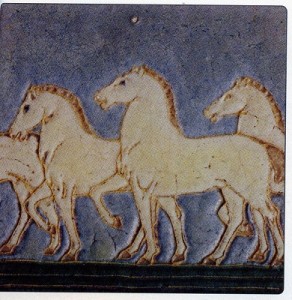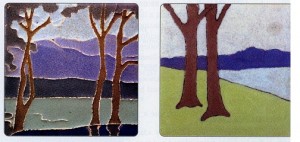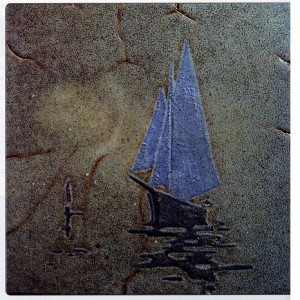By Richard D. Mohr, from Issue 20
 Tiles are hot and getting hotter—especially those from the American Arts and Crafts movement. In June 1998, tile collecting got an enormous boost from the publication of Norman Karison ‘s long-awaited book, American Art Tile (Rizzoli International). Already the world of antiques has given tile collecting its highest left-handed compliment: fakes and reproductions that are hawked as old.
Tiles are hot and getting hotter—especially those from the American Arts and Crafts movement. In June 1998, tile collecting got an enormous boost from the publication of Norman Karison ‘s long-awaited book, American Art Tile (Rizzoli International). Already the world of antiques has given tile collecting its highest left-handed compliment: fakes and reproductions that are hawked as old.
Here, gleaned from a dozen years’ experience in collecting and selling tiles, are some tips that I hope will help would- be collectors navigate the minefields. Tile collecting can be a great joy and adventure; it has been for me. I’ve also, at one time or another, made every possible tile collector’s mistake without actually destroying a tile outright. Hopefully, these suggestions will spare those starting out at least one misstep.
Jumping In
Pick a theme. There are so many different tile companies and different types of tiles out there, it’s easy to get confused, even paralyzed, by the welter of possibilities. You might want to focus, at least initially, on a single dimension of tiles— a company, a subject or a look. If you are already collecting vases, consider buying a tile or two by your favorite vase maker (Grueby, Van Briggle, Pewabic, Rookwood).
The first piece of art pottery I ever bought was a squat little undecorated Grueby pot; the next was a Grueby “Sea Birds” tile to keep it company. They’ve been happy together ever since. A friend in Los Angeles collects only Malibu tiles. These tiles are of very high quality. They are relatively plentiful—at least in California—and are varied enough in type and style so that concentrating on this company makes excellent sense. But if one were to focus exclusively on a company with a limited product ion (say, Matawan, D&M or Spartan), one would end up with a frustrated collection, even when the tiles themselves are of the finest quality, like Hartford Faience or California China Products.
A Bay Area friend collects only tiles that depict ships. This choice also makes good sense. Virtually every tile company in the Arts and Crafts tradition made tiles of ships. Frequently companies would offer several different ship
designs. So again, the possibilit ies for collecting here are rich and varied, even if focused on just one subject.
By contrast, collecting only tiles of horses would not make good sense. Even though there are some fine tiles out there (Grueby, Weller Art Tiles), there aren’t enough of them to fill out a collection. Lions make a better four-legged choice, since heraldic and other emblematic imagery was a favorite of nearly all the tile companies. Just for starters, there will be a lion in every set of zodiac tiles—Leo—— and in every set of evangelist tiles—Saint Mark.
Many art tiles were originally made for churches and cathedrals, so religious motifs are good themes as well. And Americans’ seemingly insatiable appetite for anything floral did not go unnoticed by tile companies. Somewhat more pricey but still varied and available are tiles of birds. Favored species are eagles, owls, rooks, geese, swans and peacocks. For wealthy collectors, Grueby, Van Briggle and Volkmar landscapes are a good choice.
By contrast, my own collection focuses not on a particular subject or company, but on a “look”: the murky, weird and cute. Give me a Van Briggle tile of black poppies and I get happy fast. Ditto for an Owens flambé rose.
Signatures
Don’t get hung up on them. Only a few companies signed virtually all their tiles (Rookwood, Batchelder, California Faience). Some important companies didn’t sign any of their tiles (Calco) or signed only a small number (Malibu). The majority of companies have a substantial proportion of both signed and unsigned tiles. Frequently, whether a company (e.g., Wheatley, Mosaic or Walrich) signed a particular tile or not has nothing to do with the quality of the tile, but seems to be the product of chance or whimsy. Only about half of Grueby tiles are signed. And running against
expectation, the larger and finer a Grueby tile is, the less likely it is to be signed. Ditto for Pewabic. That company signed tiles that it sold as trinkets, but left tiles made for major architectural projects unsigned. So if possessing a nice signature is a prime consideration for you, you’ll be passing up tons of great stuff and picking up lots of junk.
Sometimes one finds a design or stock number on a tile, and these frequently help in identification. But design numbers and signatures aside, tiles usually bear no other informative markings. So if you think that for a piece of pottery to be good, it needs to have as much information on it as can be found on a typical artist- signed Rookwood vase or on a 1901 Newcomb College plate, then I suggest that you collect something other than tiles.
Experienced tile dealers do not take optimistic stabs at identifying unmarked tiles; even the most reputable and experienced dealer will sometimes make mistakes. In the early l920s, there were some 50 companies making art tiles in the Los Angeles area alone—many in the same general styles and with closely related designs. Yet most of these tiles are unsigned. No wonder there is confusion. If you start collecting tiles, I advise cultivating a love of the mysterious and unknown.
Tile Backs and Clay Bodies
Pay attention to and learn from the backs of tiles and the clay from which they are made—their “clay bodies.” Clay has much more of a presence in tiles than in vases, in large part because usually more than half of a tile’s clay body is left unglazed, but also because a number of tile decorating techniques expose or profile the clay body.
The back of a tile will tell you a lot even if not in the form of a signature or date. Several companies had very dist inctive clay bodies that can help in identifying unsigned tiles. For example, Mosaic and Mueller tiles contain a lot of coarse white clay granules called “grog” within their red clay matrices. These granules of prefired clay help prevent cracking and warping, but they also flag a tile as being by one of these two companies. Most Pewabic tiles have distinctive white clay bodies that make unsigned examples fairly easy to identify. Some companies, such as Calco and California Art Tile, have distinctive impress marks resulting from the way their clay was pressed into molds. When you see a signed tile, try to imprint in memo ry the look of its clay for purposes of making future
Quality
Don’t be uncritically wowed by a company’s name. Great companies sometimes made lousy tiles. If the left side of a tile is burnt to a crisp due to poor placement in the kiln, you don’t want it even if it is a Marblehead landscape. Indeed, the
greater the company, the wider the variation in quality among its tiles of the same design. Not all Grueby “Galleons” are created equal. If someone describes one to you over the Internet, be sure you see it firsthand before you commit to buying. There are some bad examples out there of Grueby’s and Van Briggle’s best designs. The reason for this is that these companies intentionally took great risks in their glazing and tiring techniques in order to produce a few truly great examples.
They recognized that along the way some mediocre, even poor examples would result. It was larger companies one tier down in quality (like American Encaustic and Mosaic) that had to depend upon the dependable, upon routine, in order to turn a profit, and so aimed at producing tiles of uniform if not dazzling quality.
Auction catalogs frequently try to enhance the perceived quality of a tile by describing it as carved, sculpted, modeled, excised or incised, implying that the tile’s clay design is unique, the product of indiv
idualized handwork. Perhaps such descriptions flow from a blend of ignorance and wishful thinking, but they are almost never true. American tileworks employed craftsmen designers who could cleverly effect a handwrought look through the use of plaster molds. Any uniqueness that a tile has usually comes from hand glazing.
There are a few exceptions to the no-sculpting rule: Overbeck and Newcomb College tiles are hand carved, as are some North Dakota School of Mines, Pewabic and a tiny number of Volkmar and Rookwood tiles. The latter are usually artist signed by Duell, Toohey or Wareharn.

For High-end Collectors, These Landscapes May Be The Ticket: A Van Briggle Landscape (1908), Left, From the Collection of Norman Karlson, and a Rare Los Angeles Pressed Brick Company Tile By Fred Robertson (1913)
Firing Checks
Fissures that develop when the raw clay body is fired prior to being glazed and then refired are called firing checks. Usually they cut right through the whole depth of the tile. Firing checks are not damage and should not be
confused with hairlines or other cracks that result from tile abuse. By looking closely you can tell which came first—the fissure or the glaze. If the glaze was applied after the fissure formed, then it’s a firing check; if before, that’s damage.
Sometimes firing checks are a plus; Marblehead and Moravian adapted firing checks into their designs to great dramatic effect. But other times, checks are visually distracting and unpleasantly weird—just use your judgment. My advice is, don’t automatically pass on a tile just because it has a heat check.
Condition
You deserve to know when a tile is damaged, but don’t get overly hung up on damage. When contemplating a tile’s condition, think of it not as a flattened-out vase, but as a piece of furniture or a rug—something that was intended to be used and for which the category “mint” is not particularly helpful. The most important question to ask yourself is whether the wear or damage on a tile draws the eye. If the first thing you see when you look at a tile is a ding or a chip—say, a patch of shockingly white clay shining through a field of mottled matte-green glaze—then that’s a problem. But otherwise don’t worry too much about damage. Some of the California tile companies, notably Claycraft, intended their low-fired, oxide-based glaze treatments to wear oi even flake off with age. They announced in their catalogs that the buyer should expect such a “patina” of use.
Antique tile dealers do not even consider dings and chips off the back of tiles as damage that needs to be flagged to the attention of a potential buyer. If purity and perfection are your primary values, again, I suggest coll ecting something other than tiles.
ART TILE RESOURCES
ENTHUSIASTS
Tile Heritage Foundation
P.O. Box 1850
Healdsburg, CA 95448
(707) 431-8453
(707) 431-8455 fax
Friends of Terra Cotta
771 West End Avenue #IOE
NewYork,NY 10025
REPAIRS AND REPRODUCTIONS
Alchemie Ceramics Studio
C/O Walker Zanger Outlets
8901 Bradley Avenue
Sun Valley, CA 91 352
(818) 504-0235
Designs in Tile
P.O. Box 358
Mount Shasta, CA 96067
(530) 926-2629
Fulper Tile
34W. Ferry Street
New Hope,PA 18938
(215) 862-3358
Motawi Tileworks
33 North Staebler #2
Ann Arbor, Ml 48103
(734) 213-0017
Stone Hollow Tile Pottery
2115 Gordon Avenue
St. Paul, MN 55108
(651) 646-5970
Tile Restoration Center
35 II Interlake Avenue North
Seattle, WA 98103
(206) 633-4866
BOOKS
To learn more about decorative tiles and art pottery, American Bungalow recommends American Art Pottery, From Our Native Clay, Art Pottery of America, California Potteries: The Complete Book and other volumes available in The Bungalow Bookstore.
Richard D. Mohr is a professor of philosophy at the University of Illinois, Urbana.
Mohr’s informative journey into the world of tile collecting concludes in Issue No. 21. Join us then for the pros and cons of framing, tips on caring for and cleaning tiles, comments on prices and how to watch out for fakes.








A while ago I notices a tile in your magazine that featured a crow or a rook. Could you identify that tile for me? Thanks.
the Motawi Tileworks has tiles with black birds on them. Go to their website and search the “Art Tiles’ section. I was there last week (Ann Arbor, MI) and took their Thursday morning tour at 11:00 (wonderful tour) and saw them in their gift shop. It may be the one you’re looking for, but then, maybe not. Give it a go.
Pewabic Pottery in Detroit is a famous old place, and is still very active today with tours and classes, and of course still producing beautiful tiles and pottery.
http://www.pewabic.org/
I have a Batchelder fireplace. What is the feasibility of taking it with me when I move? How would I remove them safely?